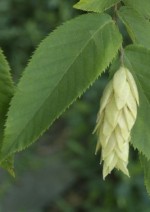 This deciduous understory tree is native to eastern United States where it can be found on dry slopes and woodlands. It is small to medium in size with upright spreading branches, and conical form when young becoming rounded in maturity. The simple yellowish-green leaves are oval with doubly serrate margins. In the fall they become an uninteresting yellow and may drop early. Male and female catkins are produced on the same tree in spring but are not ornamental. The female catkins, however, develop very attractive pendulous clusters of inflated, seed-bearing pods that are green changing to brown and resemble the fruit of hops, hence the common name. The gray-brown bark exfoliates in narrow vertical strips and the trunk becomes fluted and often twisted. The wood is very hard and the tree is also called ironwood. American hop-hornbeam makes a lovely lawn or street tree but should not be planted along streets that are salted in winter because of its lack of salt tolerance. It is difficult to transplant but does well from a container.
This deciduous understory tree is native to eastern United States where it can be found on dry slopes and woodlands. It is small to medium in size with upright spreading branches, and conical form when young becoming rounded in maturity. The simple yellowish-green leaves are oval with doubly serrate margins. In the fall they become an uninteresting yellow and may drop early. Male and female catkins are produced on the same tree in spring but are not ornamental. The female catkins, however, develop very attractive pendulous clusters of inflated, seed-bearing pods that are green changing to brown and resemble the fruit of hops, hence the common name. The gray-brown bark exfoliates in narrow vertical strips and the trunk becomes fluted and often twisted. The wood is very hard and the tree is also called ironwood. American hop-hornbeam makes a lovely lawn or street tree but should not be planted along streets that are salted in winter because of its lack of salt tolerance. It is difficult to transplant but does well from a container.
Type: Deciduous tree
Outstanding Feature: Fruits, bark
Form: Conical when young, rounded when mature
Growth Rate: Slow
Bloom: Male and female catkins produced on the same tree in spring; fruits resemble hops
Size: 30-50’ H x 20-35’ W
Light: Full sun; tolerates some shade once established
Soil: Fertile, moist, well-drained, slightly acidic but tolerates some dryness once established
Hardiness: Zones 4-9
Pests and Diseases: None of significance
Propagation: Seed.
